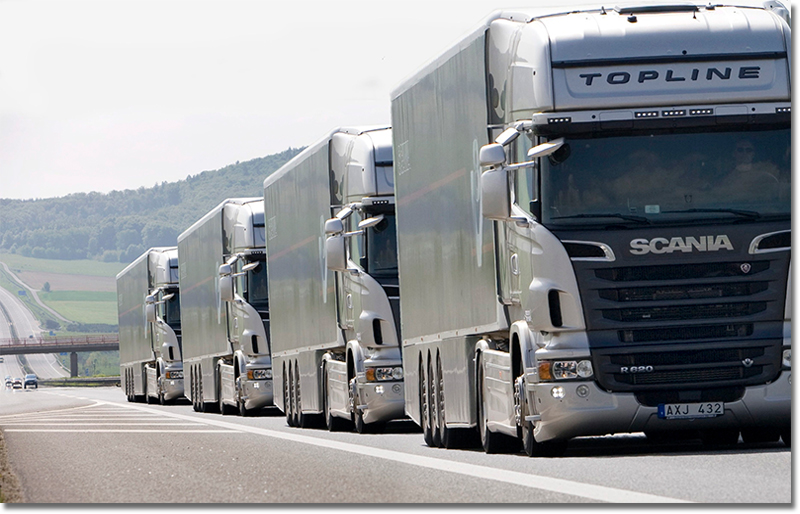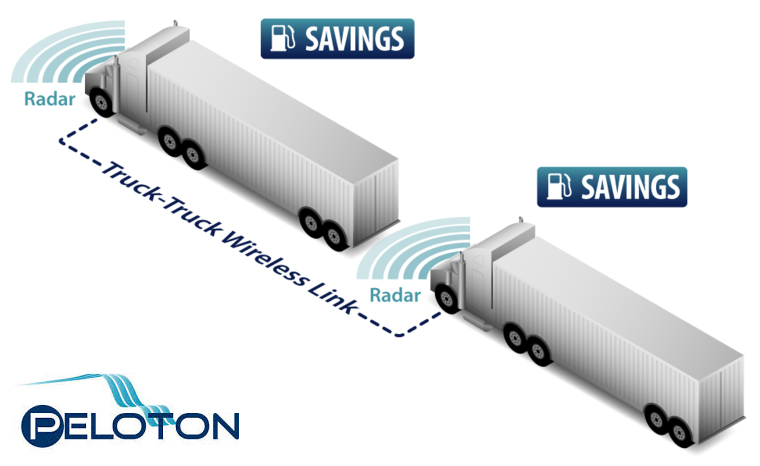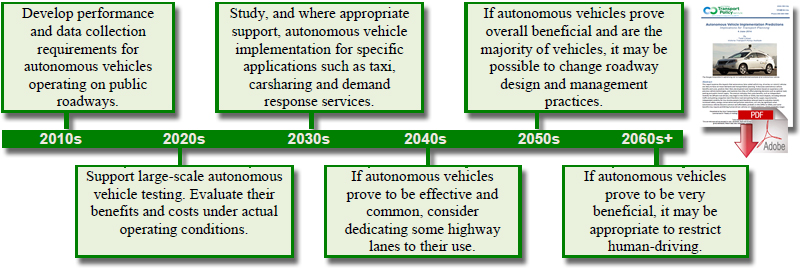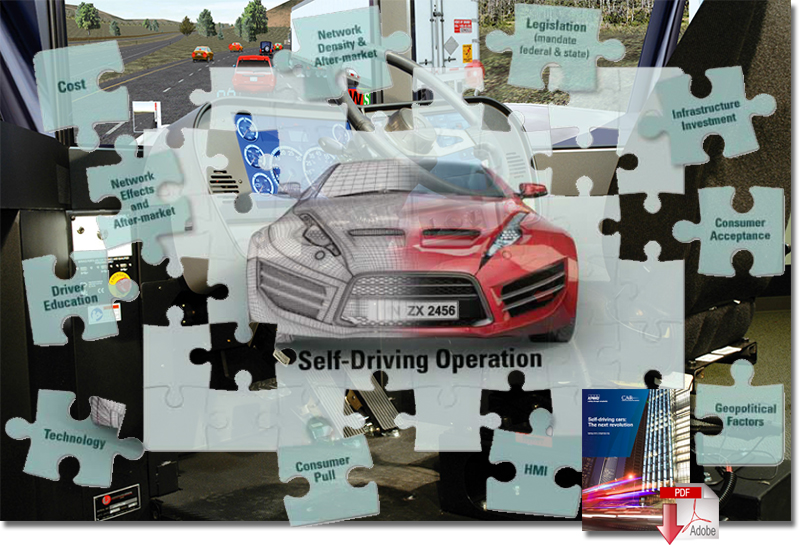When Google debuted its prototype driverless car, there was lots of talk about how the product would someday change your life, while simultaneously putting hundreds of thousands of cab drivers out of work.
But this technology seems likely to deeply alter a bigger industry that’s much more fundamental to the American economy than taxis.
That’s the long-distance trucking industry, which carries about 68.5 percent of all goods shipped in this country — and employs about 1.7 million who drive vehicles.
Driverless technology holds a number of advantages over human drivers in all sorts of areas. But it’s particularly well-suited to take over trucking very soon for several different reasons.
Driverless truck experiments are already underway in Japan and Europe, and now testing of semi-autonomous trucks has begun in Nevada. Here are the reasons why they’re destined to succeed — and why you’ll probably pass a driverless semi before you ever see a self-driving car.
Computers Are Cheaper and More Flexible Than Humans
The most immediate reason why driverless technology will doom truckers is the same reason it’ll be the end for cab drivers: the cost of a machine operating a vehicle will be dramatically cheaper than the cost of a human.

A semi-autonomous convoy experiment in Sweden. Scania
It varies widely, but on average, paying drivers accounts for 30 percent of the cost of shipping something by truck in the US. And there are reasons to think eliminating drivers will save trucking companies even more money than they’ll save Uber — eventually reducing the cost of trucked goods.
Related: ‘Uber for Logistics’ is Already Happening in Asia, and Uber is Getting Left Behind
One of the things that drive up the cost of drivers is the simple fact that long-haul trucking is a much more unpleasant lifestyle than driving a cab. Many drivers spend five or six days a week on the road, which is why trucking has such an extraordinarily high turnover rate (about 98 percent annually) and why the industry constantly struggles to find enough drivers, even when unemployment is high.
Obviously, machines won’t care about these lifestyle difficulties. In fact, the Australian mining company Rio Tinto has already begun implementing autonomous trucks at its remote iron ore mines, partly because it’s so expensive to get drivers to come live in those places.
Another factor is that unlike for taxis, limits on the number of hours a person can drive also drive up the cost of transport. A trucker can legally only drive for 11 out of every 24 hours, so shipping something cross-country requires delays for sleeping, or paying two drivers who trade off. That won’t be the case with driverless trucks, which will also be able to more easily take advantage of traffic-free interstates at night.
Related: Truckers Highlight Regulatory, Fatigue Issues After Tracy Morgan/Walmart Crash
Driverless Technology Will Be Ready For Highways First
Engineering a vehicle that can drive at a constant speed on a predictable highway is a much simpler problem than designing one that can drive on city streets, which are filled with traffic lights, pedestrians, and other sudden obstacles.
That’s the reason why Google began is self-driving car program with experiments on highways. And the vast majority of long-haul truck miles are logged on the interstate system, making it a convenient industry to begin implementing driverless technologies — including some that are already used.

In most tests, a specially trained driver in the lead vehicle controls all other vehicles in the train, allowing their drivers to kick-back and relax. Satre
Though Google’s new flashy car is getting the most press, you’ve probably already experienced semi-autonomous driving capabilities that have been rolled out in human-operated cars: things like adaptive cruise control (which can slow you down if there’s a car in front of you) and systems that alert you if you begin drifting out of your lane.
Several different projects in Europe, Japan, and the US have recently begun adapting these technologies for trucks. They generally involve trains of vehicles made up of a lead truck (driven by a human) and several trucks and cars that follow it (each with a human inside, but guided by computers).
This sort of semi-autonomous driving tech could be useful in all vehicles, but it’d be especially valuable for companies with fleets of long-haul trucks.
One reason is how easy it would be to eventually eliminate the idle drivers in the rear vehicles. Early on, before driverless trucks are ready for city streets, you could have drivers waiting and ready to take the trucks over after they exit the Interstate. Eventually, you could do away with the humans altogether and save that 30 percent spent on pay.
But equally important is the fact that packing trucks together in trains saves costs in a different way:
Trains of Driverless Trucks Are Way More Fuel Efficient

We are hard at work solving the two biggest challenges facing the $650Billion trucking industry: Accidents and Fuel Use. Peloton
Between 20 and 40 percent of the cost of shipping something by truck goes to fuel. A large amount of this fuel is simply burned as the engine fights air resistance, because trailers are so boxy and unaerodynamic. One way of cutting down on it is driving trucks in tight packs, so one can draft behind another.
Of course, it’s not safe for human drivers to draft off each other in this way, because it doesn’t allow for enough reaction time if the truck in front stops suddenly. But computers can do it, and recent tests in Nevada showed just how much fuel they can save.
The experiments by Peloton, a company that’s developing truck caravan technology in partnership with the Department of Transportation, showed that while traveling at 65 miles per hour 36 feet apart, two trucks packed together saved seven percent on fuel. This was the average for just two trucks (the lead saved 4.5 percent, and the rear saved 10 percent), so it should increase as trains get longer.
Last summer, the EPA introduced new fuel standards for heavy-duty vehicles that call for tractor-trailers to reduce their fuel consumption by 20 percent by 2018. It’s doubtful driverless technology will be ready that fast, but the new standards highlight the priority of cutting down on carbon emissions from long-haul trucks, which account for about 6 percent of total US emissions.
What Obstacles Need To Be Overcome For Driverless Trucks?
The factors that block a broad rollout of self-driving trucks fall mainly into two categories.
One is safety. People are understandably concerned about the idea of computers driving cars around on the roads, and those worries are amplified for tractor-trailers that can weigh up to 80,000 pounds when fully loaded.
But experts actually predict that automated systems will make trucking safer, by eliminating distracted driving and human error. And Google’s driverless cars, at least, have now gone more than 700,000 miles without an accident.
Obviously, their safety needs to be proven before these trucks are filling the interstates. But this may be a surmountable concern, especially since the technologies can be implemented piecemeal, initially as part of convoys with drivers still in lead vehicles.
Autonomous Vehicle Planning Impacts Time-Line

Summary of how autonomous vehicles are likely to impact transport planning.
In a sense, a single driver leading two trucks linked digitally isn’t all that different from the drivers that already pull two trailers linked physically, and these convoys may gradually get people used to the idea of autonomous trucks.
The other problem is legal. Right now, just a few states (including California, Nevada, and Florida) have laws on the books regarding driverless cars, and their legal status as a whole is murky. For driverless trucking on Interstates to be practical, all states would need to explicitly allow these vehicles on public roads.
Advocates are hopeful that national legislation will solve this problem. It’s all very uncertain, but in 2012, Google’s Sergey Brin predicted the Department of Transportation would begin regulating autonomous vehicles nationally as early as 2017.
And it seems likely that if self-driving cars were legalized, driverless trucks — which, though heavier, would mostly operate in a simpler, more controlled environment and would be exclusively owned and maintained by professional companies — would be allowed too.
Source: Vox
Download the Paper: Self-driving Cars: The Next Revolution

Related: Self-Driving Trucks to Revolutionize Logistics

Article topics
Email Sign Up

















